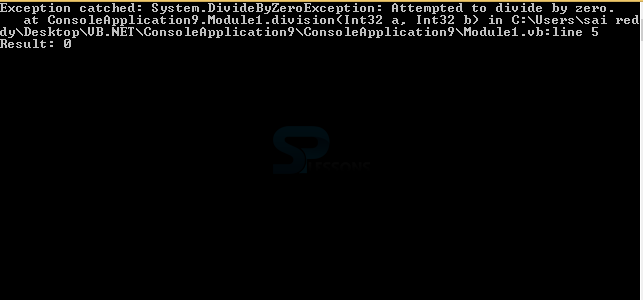 Description
Description
An Exception is used to avoid the errors during the execution of the program. Exception Handling is a mechanism in the VB.Net to handle the problems occurs by the wrong code or by some other reasons. Because of the Exception Handling, the execution may not stop.Following are the types of an errors.
- Syntactical Errors: Occurred when the code is written with inappropriate syntax.
- Runtime Errors: Occurred when the code is written with the logical mistakes
 Syntax
Syntax
[vbnet]
Try
[ Statements ]
[ Catch [ exception [ As type ] ] [ When expression ]
[ Statements ]
[ Finally
[ Statements ] ]
End Try
[/vbnet]
The following is the Description about the main parts in the above syntax.
Try: Having the code where there is a chance to occur error.
Catch: Having the related exception to activate if the error occurred.
Finally: Having the code that must be executed does not matter whether the exception raised or not.
 Classes
Classes
The following table shows you the different exceptions classes which are inherited from the System.Exception Namespace.
| Exceptions Classes | Description |
|---|---|
| System.OutOfMemoryExecption | Used to Handle Errors Produce from insufficient memory |
| System.DivideByZeroExecption | Used to Handle Errors Produce from dividend with zero |
| System.IndexOutOfRangeExecption | Used to Handle Errors produces from array index out of range |
| System.NullReferenceExecption | Used to Handle Errors produces from null object |
| System.StackOverflowExecption | Used to Handle Errors Producer from Stack overflow |
| System.InvalidCastExecption | Used to Handle Errors Producer from during typecasting |
| System.ArrayTypeMisMatchExecption | Used to Handle Errors Producer from mismatched with the array type |
| System.IO.IOExecption | Used to Handle I/O Errors |
 Example
Example
See the simple example given below to know "How to handle Exception".
[vbnet]
Module ExceptionHandlingExample
Sub division(ByVal a As Integer, ByVal b As Integer)
Dim Result As Integer
Try
result = a \ b
Catch e As DivideByZeroException
Console.WriteLine("Exception catched: {0}", e)
Finally
Console.WriteLine("Result: {0}", Result)
End Try
End Sub
Sub Main()
division(5, 0) 'Here, we are trying to divide with the zero
Console.ReadKey()
End Sub
End Module
[/vbnet]
Output:
Following is a result where exception occurred.
 Example
Example
Now, write the following code and try to execute the code.
[vbnet]
'Code without Exception Handling
Module Module1
Sub division(ByVal a As Integer, ByVal b As Integer)
Dim Result As Integer
Result = a \ b
Console.WriteLine("Result: {0}", Result)
End Sub
Sub Main()
division(5, 0)
Console.ReadKey()
End Sub
End Module
[/vbnet]
Output:
See the above figure and observe the difference between the with and without Exception Handling. If we don't use Exception Handling, then we will get interruption by the above error.
 Points
Points
- Exception occurred data will be placed in try block.
- Run time error means logical error.
- Developer can use throw statement in catch block to through an object.





